10 Best Email and SMS Marketing Software, Services & Platforms [Ranked & Reviewed]
Explore the future of marketing & drive business growth with the best email & SMS marketing software, combining powerful tools for a comprehensive...
Unlock eCommerce success with these 9 powerful marketing automations. Streamline marketing efforts & maximize revenue with our comprehensive guide.

And while it doesn’t seem like you’ll be able to clone yourself for another decade or two until scientists crack the code, one tool gets you as close as humanly possible to copying yourself and applying that potential to your business: marketing automation.
Automations seem to be everywhere, you can’t walk by your local grocer without getting a text the next day asking if you want to subscribe to their newsletter. But that doesn’t mean automation has jumped the shark because the number of brands doing it well are few and far between.
When done the right way, marketing automation feels like giving your customers their very own personal shopping assistant—and they love it!
When marketing automation software monitors your customer’s behavior (responsibly, of course) and responds in real-time to deliver real value and just the right time—magic.
Just some of the benefits you could see when you effectively use automations are:
Keep reading to learn how some of the largest eCommerce brands in the world use marketing automations to crush their competition and skyrocket their revenue.
| TLDR Key Takeaways |
| Automating your customer retention campaigns unlocks unprecedented revenue opportunities for eCommerce businesses of all sizes. Understanding what your audience needs, and when, is critical to building customer retention automations that don’t feel like spam. There are some pillar automations that you need to have in place to be successful, like the welcome series, and abandon cart—start there and build. |
Most eCommerce marketing automation solutions use the concept of triggers and actions, or trigger marketing, to set up their automations—even if they say otherwise.
So what is a trigger and an action? Let’s take a closer look at some specific terms we’re going to talk about:
Automation solutions are typically built around if-then functions to specify which triggers and actions to follow up with. These can be constructed simply (if they do this, then send that), or they can be built to handle complex and time-delayed functions.
How does this look? Let’s take a look at an example.
If the customer abandons their cart, then the system will wait ‘X’ amount of time before sending out a “Your Cart’s Waiting For You” (abandoned cart) email. This would then branch off into two options:
Check out how you can quickly build powerful marketing automations using Patch:
When you spend the time to build out these custom triggers and actions, you ensure that your customers are getting the right message at the right time—helping you push them down the sales funnel and generate more revenue.
Let’s break down six automations you should be using right now – and highlight who is doing a great job at it already.
While marketing automations may look daunting for beginners, it’s well worth the effort to master this tool.
To help you get started, here are nine of the best eCommerce marketing automation strategies to start using today.
In a welcome series, you build your relationship with your customers by sending them a series of emails and texts after they start engaging with your brand. Remember, the first engagements with your customers typically have the most impact.
To do this, you’ll start by providing them with useful information about your brand, setting the standard for how often you plan on contacting them, and providing them with a special offer for signing up.
Next, you’ll want to send out another email encouraging them to connect with your social pages and make sure they know how to connect with you directly if they have any questions.
Using automation tools, you can create personalized welcome series for each individual and schedule their release, ensuring the best customer experience.
Here’s an example of how Riley Home tailors their message and offers a promotion in the first email of their welcome series:

Sometimes customers simply lose track of your brand. In fact, we conducted a survey that showed 31% of customers didn’t return because they simply forgot about it—that’s why you need win-back campaigns.
The ultimate objective of these campaigns is to re-engage your customers and bring them back to the table. From a gentle reminder to a special promotional offer, there are many ways you can reach out to them.
Automation makes this easy because it tracks who’s been actively engaging with your brand and who’s starting to fall behind. When a customer reaches a certain threshold, your system will automatically try to re-engage them.
Here’s a prime example of how Chewy uses its win-back campaign to promote special offers and engage the customer by using data from previous purchases to hook them from the get-go.

If you’re not using automations for your win-back campaigns, you’re basically throwing spaghetti at the wall to see what sticks.
With automated customer retention, in contrast, it’s like assigning a personal assistant to each of your customers.
Automated marketing platforms such as Patch makes it easy to automate the customer journey, letting you set up specific triggers if your customers fall behind.
Use their name, address, intent signals, purchase history, and other customer data to feed the system to get data-driven insights into how you should go about your win-back campaigns.
This means you can focus on building retention campaigns that actually work.
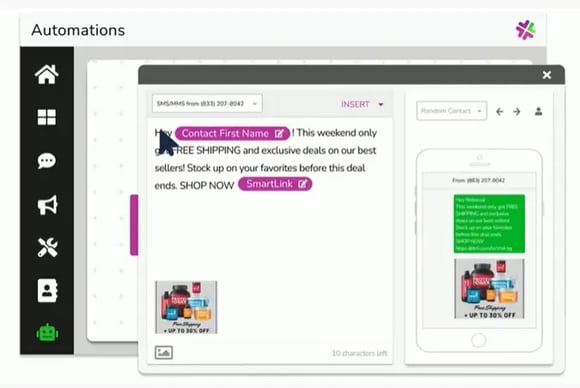
There are a number of ways you can nudge your potential customers in the right direction.
You might send them an SMS or email to remind them about something they need, offer some freebies with a purchase, sweeten the deal by offering an extra special promotion, or provide another incentive.
Cart abandonment is the plague of the eCommerce world, costing brands more than $18 billion in revenue annually.
If you’re not doing anything about this issue, you’re leaving so much money on the table it hurts—this is your money slipping through your fingers.
eCommerce brands combat cart abandonment with marketing automation workflows that send personalized abandoned cart emails and text messages reminding customers of the items they left behind and encouraging them to complete their purchases by offering assistance and answering questions.
These campaigns have been shown to effectively reduce cart abandonment rates and boost revenue for eCommerce brands.
Nomad does a great job of getting users to return to the store to complete the checkout process with powerful visuals and copy.
Patch has seen tremendous success with simple SMS campaigns offering assistance to customers that engage live reps if the end user responds.
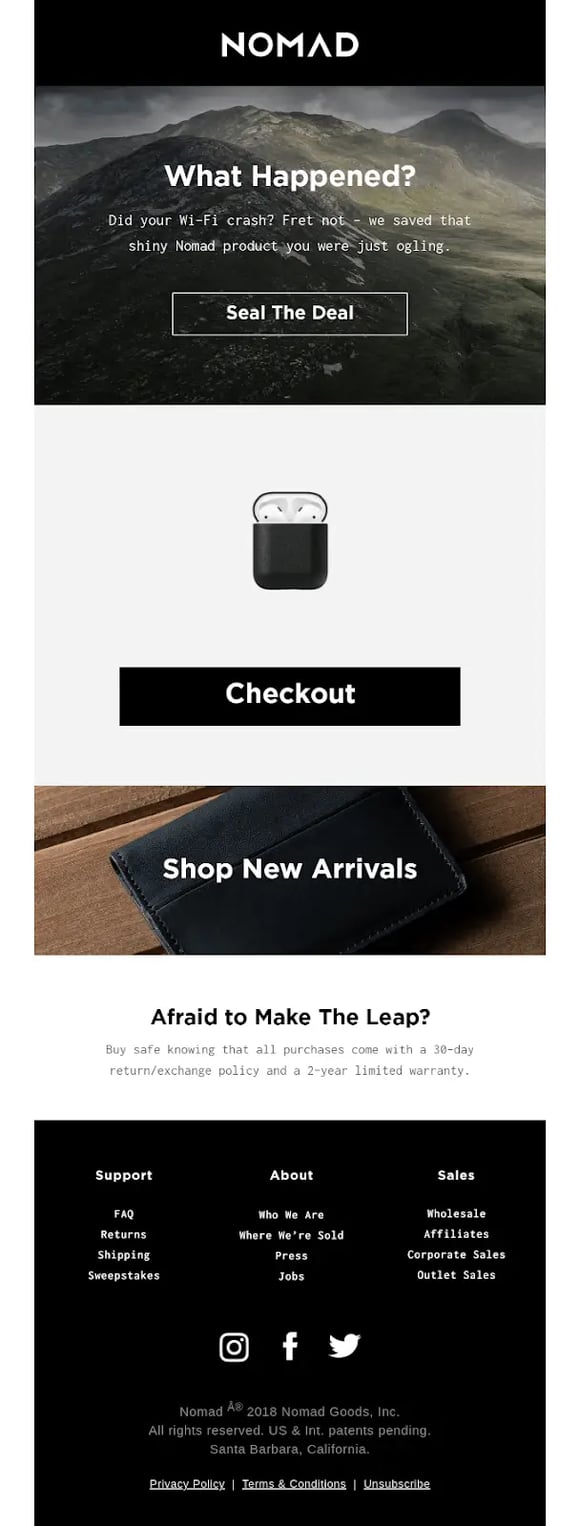
By setting up automated rules, businesses can automatically send abandoned cart alerts when certain conditions are met, helping strike the right balance between being timely and not being overly intrusive.
How do you know where that fine line is?
Relying on guesswork is the surest way to fail, but fortunately, marketing automation platforms come with powerful analytics and reporting tools to help you make data-driven decisions.
You can’t really get more accurate than this. Here’s how Patch segregates customers to help eCommerce businesses target them more effectively:
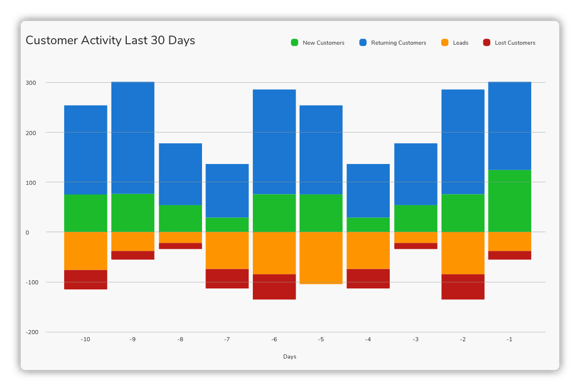
Additionally, you can take it to the next level by customizing your abandoned cart alerts based on the user’s behavior, purchase history, content preferences, and other factors to deliver a truly personalized shopping experience.
Cross-selling and upselling are essential ecommerce strategies for increasing revenue per customer.
By offering related products or upgrades at the point of purchase, ecommerce brands encourage customers to spend more, drastically increasing their lifetime value.
Marketing automation can be a valuable tool for executing these strategies effectively. Send targeted emails and advertisements to customers based on their purchase history and previous interactions.
Additionally, if a customer expresses interest in a product but doesn’t purchase it, the site can use marketing automation to send them reminders or special offers.
Dollar Shave Club nailed this strategy with branded, to-the-point emails like this one:
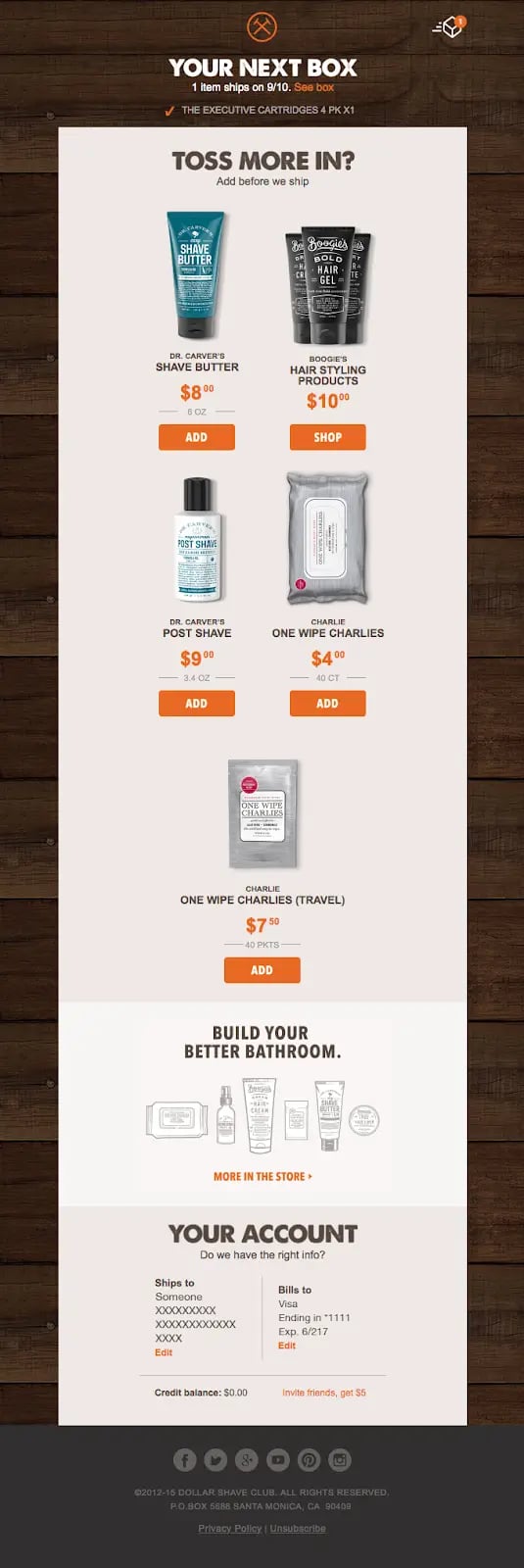
Most brands’ marketing resembles a dry monologue—they send you stuff; you listen. The most successful eCommerce companies, however, take a different approach, cultivating a dialogue where every opinion matters.
Something as simple as a customer feedback survey can go a long way, helping you improve your products, enhance customer experience, and show that they truly care.
By using automated surveys as well as both sms and email campaigns, you can streamline the entire process while achieving higher response rates since most automation platforms allow you to send targeted messages.
As a quick example, here’s how Sightglass Coffee subtly gets their customers more engaged with the brand, building loyalty one step at a time:
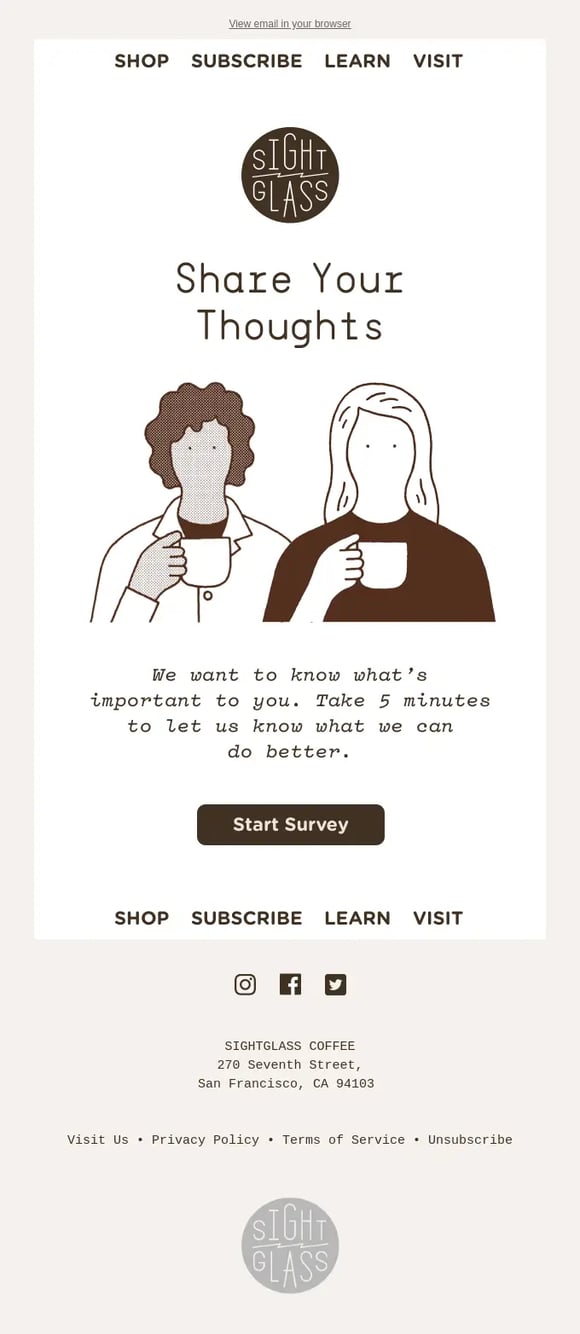
Here is another example of how you can utilize service interactions with your customers to solicit review requests via automations:
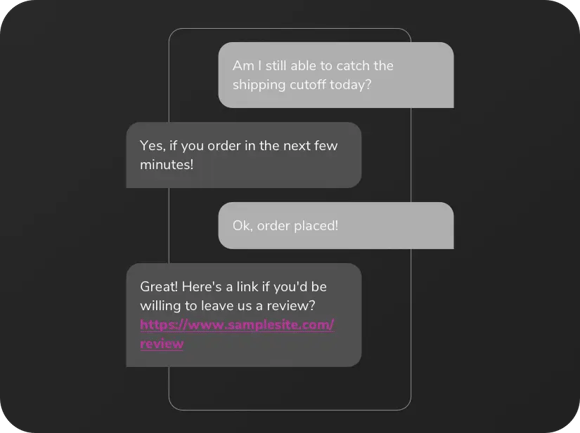
A nurture campaign is designed to cultivate and nurture sales by providing educational, non-promotional content over an extended period of time.
A nurture campaign aims to build trust and rapport with passers-by so that they eventually become customers.
With the power of automations, you can create highly targeted nurture campaigns to win their loyalty.
You’re not just yet another store where all of your marketing tactics are aimed at making as much money as possible. You’re their friend and trusted counselor, helping them make an informed decision.
Here’s an example of how Harry’s, a premium men’s grooming brand, leverages informational content to cultivate loyalty and retain more customers.
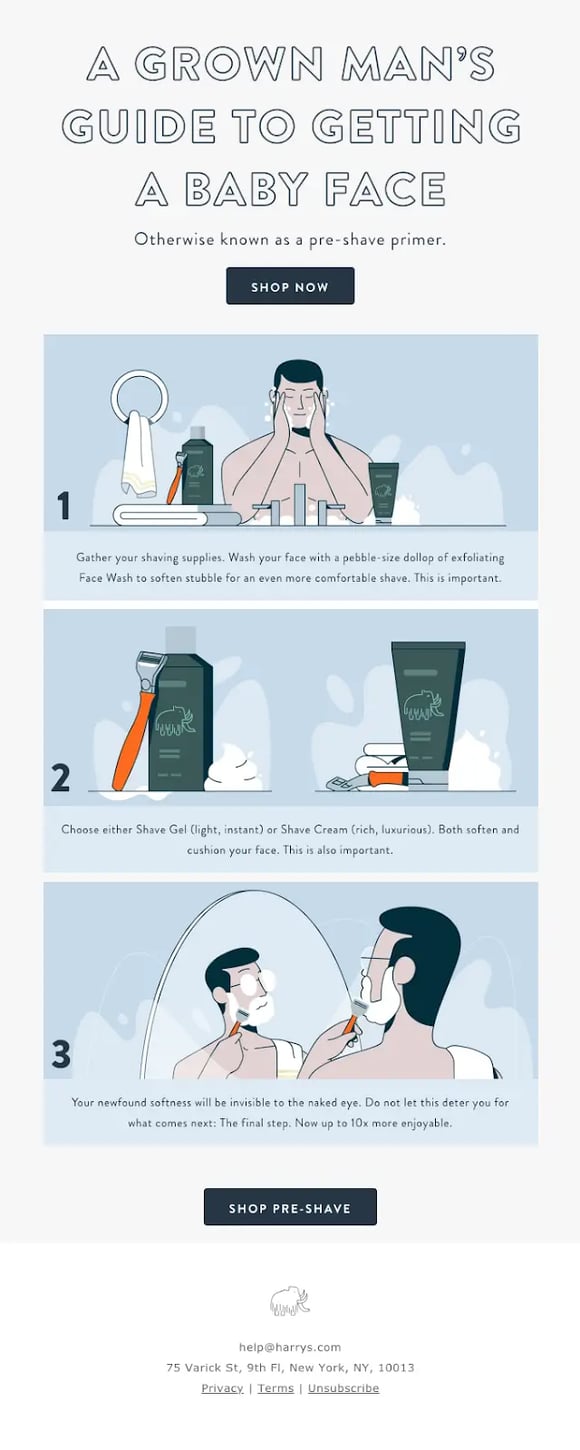
(Source)
How do you feel when you get those “Dear Sir/Madam” cold emails? Pretty annoyed, right?
That’s exactly what customers feel when brands fail to personalize their offers and messaging.
Personalized discounts, promotions, or other types of special offers tailored to the specific needs and interests of an individual customer beat generic, spray-and-pray campaigns any day of the week.
Before marketing automations came into play, the hands of marketers were tied. With SmartOption, it’s an entirely different story.
Here’s how Domino’s leverages multiple data points to create a powerful personalized message to drive more sales—at scale:

You can spend days creating custom segments, but what you truly need is SmartOption from Patch.
SmartOptions allow for hyper-targeted and personalized messaging that allows companies to use customer-specific links, data, and offers to generate viciously effective customer retention campaigns.
It’s like creating a separate marketing campaign for every single customer.
In addition, Patch automatically generates single-use codes to prevent coupon abuse and fraud.
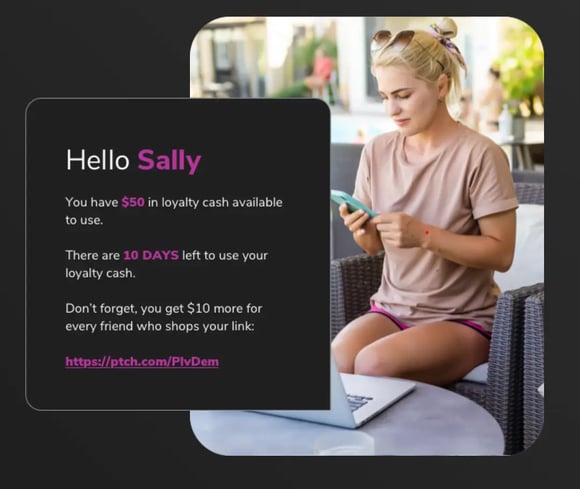
eCommerce businesses rely heavily on customer reviews to help drive sales and revenue.
Customer reviews are one of the most trusted forms of social proof, helping increase confidence in potential buyers considering your products.
But how do you solicit customer reviews without sounding desperate?
GIGI PIP, an eCommerce brand selling designer women’s hats, offers loyalty points in exchange for leaving a review. How does it work for them?
With over 2,400 reviews on Google alone, as you can see, it works pretty well.

eCommerce marketing automation platforms such as Patch (shameless self-promo) allow you to leverage the aggregated customer data to generate customer reviews on autopilot by identifying:
There’s no way you can do that manually, but with Patch, it’s as easy as shelling peas.
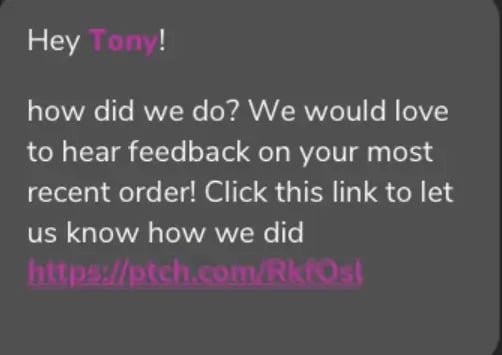
Loyalty and rewards programs are designed to retain customers by providing incentives to re-engage with the brand and buy more.
Typically, these programs offer points or rewards for making purchases, which can then be redeemed for discounts or free products.
In some cases, eCommerce businesses also offer exclusive deals and promotions to members of their loyalty program.
This is as far as most brands go with their loyalty marketing. Here’s one problem with this approach, though.
It barely even scratches the surface of what’s possible when you use loyalty & rewards programs the right way.
Loyalty marketing is just as art as it is science. Here’s how Chipotle retains new customers by giving away loyalty rewards (that you can’t spend anywhere but with Chipotle):
Patch empowers businesses to create powerful loyalty & rewards programs that leverage the power of automation to run it on autopilot.
The possibilities are virtually endless. As opposed to just rewarding customers just for sticking around or buying from you, here are just some of the other things you can do:
Here’s how Patch makes it seamless to set up and integrate a professional loyalty program for eCommerce businesses:
Your eCommerce marketing automation strategy is only as good as the software you rely on to get the job done.
But how do you make the right choice? Here are some of the things you need to look at to properly vet your eCommerce marketing automation platform.
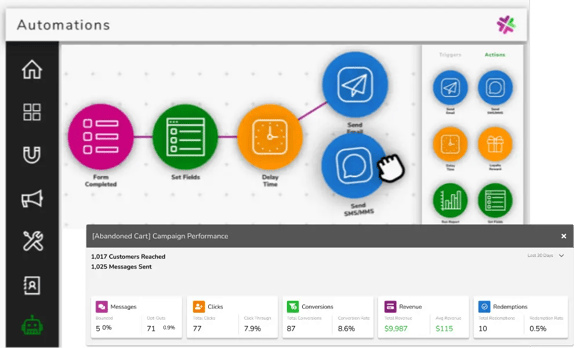
The first thing you need to look at is your platform’s core features and capabilities.
Ensure that you have enough actions and triggers to work with to create hyper-targeted automations that feel personal.
Some of the triggers you need include:
When it comes to actions, here are some basic essentials you need to have to create effective eCommerce marketing automations:
In addition, check to see if the software is compatible with your existing eCommerce platform.
Your marketing automations are the engine that keeps on running by itself—but only after you’ve done enough tweaking and fine-tuning.
If you’re going through the setup process on your own, chances are, you’re going to miss out on the full potential of your platform, drastically reducing the ROI of your efforts.
That’s why it’s essential for you to have access to hands-on support and onboarding assistance to get the most out of your marketing automations.
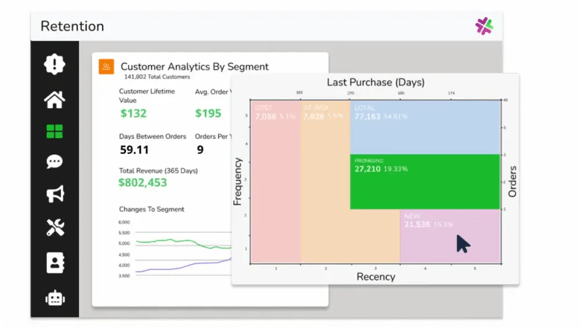
When choosing ecommerce marketing automation software, it is important to consider the analytics and reporting capabilities of the platform.
Marketing automation software collects and processes massive volumes of data to generate reports that provide insights into customer behavior and pinpoint areas of improvement.
Without these capabilities, it would be difficult to track the success of marketing campaigns and make informed decisions about where to allocate resources.
These are a lot of eCommerce metrics, but some of the most essential are as follows:
Marketing automation opens up a new world of opportunities for eCommerce businesses.
When done the right way, it’s like having a team of customer support reps, salespeople, and marketers working around the clock to grow your business.
If you still haven’t jumped on the bandwagon, you’re missing out on a major opportunity to take your business to the next level.
Patch is the ultimate eCommerce marketing automation platform helping brands of all sizes retain more customers to boost their sales through the roof.
Our all-in-one solution has everything you need to keep your customers coming back for more.
Want to see it in action? Get in touch with us for a free demo.
Explore the future of marketing & drive business growth with the best email & SMS marketing software, combining powerful tools for a comprehensive...
Learn the step-by-step process of creating buyer personas that will fuel your data-driven marketing strategies and ensure you reach the right...
Get ahead of the competition with these 6 proven mobile email design best practices. Maximize engagement and boost your email marketing performance.